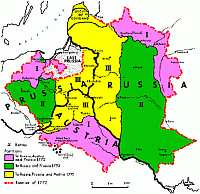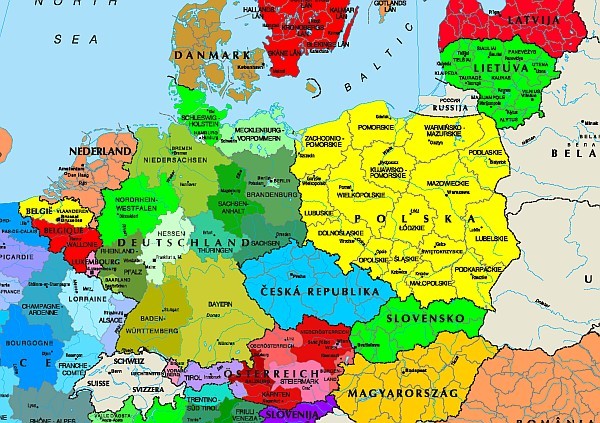The 18th and 20th century settlement: coexistence of nations and religions

Poland in 18th century
|

Poland in 20th century |
In the second half of the 17th century, and especially in the 18th century, countless wars, natural disasters, and plagues swept through the Polish countryside wreaking havoc and decreasing the population size. Hence, it was necessary, not only to settle the dilapidated and abandoned lands, but also to colonize new areas. As a result, a new settlement process was initiated; it reached its apogee in 1701 and lasted until the first partition of Poland.[1]
In the middle of the 18th century, the Dutch settlements lost their uniform character in terms of their economy and ethnicity. Dutchmen still inhabited the settlements, but the population became predominantly German (Lower Saxony) and Polish. The name Olęder acquired a specific meaning. In its Polonized form, it ceased to denote the settler's nationality, and started rather to describe a specific model of farming and social organization[2]. Especially because, due to Friedrich Wilhelm's politics, there was an increased inflow of German colonists in Polish lands.
Large groups of people moved from central and southern Germany, firstly to Eastern Prussia, and then to the lands of former Poland. In 1732, the ruler issued an edict that stated that all Mennonite conscientious objectors were to leave the state of Prussia[3]. The villages Błotnica and Głęboczek, situated in the Noteć river valley, were founded at that time[4].
After the first partition of Poland, the rights of conscientious objectors were even further limited as a result of the militaristic policies of Friedrich Wilhelm II. This action pertained to the Mennonite villages located within Prussian borders by the Vistula river and in Żuławy. Finally, the edict issued in 1789 sealed their fate. This document forbade group members to lease land or own property. According to the edict, Mennonites who were dodging military service had to pay the army 1 gulden each. In addition, Mennonites were officially included in the Evangelical Church, whose duties had just been increased[5].
Together, these drastic actions of the Prussian authorities led to the emigration of the Mennonites. In 1786, a special envoy of Catherine II proposed that the Mennonites settle in Russia. In the same year, this proposal was additionally confirmed by members of a special tsarist commission. This offer included very attractive conditions: transport to Russia free of charge, 80 hectares of land per family, credit, which was to be paid after the first harvest, and religious freedom. Thus, in 1789, the first group of emigrants left the Gdańsk region and moved to southern Russia, where the colonists founded the settlements Moloscha and Chortica[6]. At the same time, Mennonites founded two villages in the Lwów region. The villages were established under the Tsar's decree, which also exempted Mennonites from military service.[7]
During the Napoleonic wars, many Mennonite villages were again included under Prussian rule. Considering the state of affairs, some of the residents of the Poznań region moved to Wymyśl and Kazuń, which were situated within the borders of the Kingdom of Poland. The settlers residing in this area enjoyed extensive legal and self-governing rights. Owing to the change of land ownership rights (the settlers became rightful owners of land and not its lease holders), the Mennonites were growing wealthy, which contributed to a loosening of religious ties.
At the end of the 19th century (starting in 1873), the former area of Poland again became a destination for Mennonites' immigration. This time their origin was from Russia. The direct cause of their emigration was the tsar Aleksander's decree that forced them to enlist in military service. Leaving Russia, they would cross Polish lands and then via Gdańsk emigrate to the United States, Canada, Brazil, and even Argentina[8]. Those, who remained were exiled to Siberia in 1917.
Mennonites survived in Poland as a religious sect until 1945, when they were forcibly displaced. Polish Mennonites, in the inter-war period, constituted the second most populous group in the world. Although their majority lived in Żuławy, they also inhabited other regions of Poland; for example, in the villages: Przechówka, Nowe Wymyśl, Wola Wodzyńska, and Kazuń Niemiecki, where they constituted a majority. In other Olęder villages they were in the minority, with only a few families or individuals living in many villages.
Quite often, they passed themselves off as Germans[9] , who often were their neighbors. However, most of them preserved a certain sense of identity, consciously trying to cultivate their Dutch roots. Mennonites considered themselves a separate group, and placed themselves higher than their fellow evangelical settlers. Neither have they forgotten the persecutions they suffered from the Prussian government in the past. They regarded their place of stay as a homeland, especially because the Polish government treated them favorably.
In Małopolska and in the central provinces, Mennonite congregations kept records separately or together with Evangelical congregations. The Ministerstwo Spraw Wojskowych (Ministry of Defense), on November 27, 1925, issued a decree that released the soldiers of the Mennonite denomination from taking a regular oath and provided a special oath, to which they could give a positive answer. Special instruction was issued in 1931, which enabled Mennonites to serve in sanitary units of the army[10]. The total number in Poland, according to a census from 1921, equaled approx. 1500.
[1] K. Ciesielska, Na marginesie nowszych prac zachodnioniemieckich nad osadnictwem Prus Królewskich w XVI-XVIII w., "Zapiski Historyczne", t. 26, z. 4, 1961, p. 118.
[2] I. Baranowski, Wsie holenderskie na ziemiach polskich, "Przegląd Historyczny", t. 19, 1915, p. 70.
[3] X. K.Zimmerman, Fryderyk Wielki i jego kolonizacja na ziemiach polskich, Poznań 1917, p. 67.
[4] Mennonitisches Lexikon, Karlsruhe 1967, p. 263.
[5] W. Marchlewski, Mennonici w Polsce (o powstaniu społeczności mennonitów Wymyśla Nowego), "Etnografia Polska", t. XXX, 1986
[6] C. J. Dyck, An introduction to Mennonite History, Scottdale 1972, p. 128.
[7] W. Marchlewski, Mennonici w Polsce (o powstaniu społeczności mennonitów Wymyśla Nowego), "Etnografia Polska", t. XXX, 1986, p. 134.
[8] C. J. Dyck, An introduction to Mennonite History, Scottdale 1972, p. 140.
[9] Index of Polish towns based on the first census from September 30, 1921 and other official sources; vol. 1, city of Warsaw, Warsaw province, Warsaw 1925.
[10] S. Grelewski, Wyznania protestanckie i sekty religijne w Polsce współczesnej, Lublin 1937, p. 513.
|

